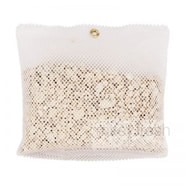Allergic to pets, particularly to dogs and cats, did you know they are a common cause of allergic disease, including asthma and allergic rhinitis (hay fever)? Pets are an important source of health benefits to many individuals and close contact like in homes, and can be associated with a variety of risks (Ownby & Johnson 2016).
An allergic reaction to household pets is caused by the proteins from the animal’s hair, saliva or urine. When in contact with the skin or breathed in, these can irritate the eyes and airways, similar to hay fever and asthmatic symptoms. They can also irritate the skin, cause rashes and in some cases eczema or atopic dermatitis.
Naturally, kids play with cats and dogs. Their pet licks them, transferring saliva containing millions of bacteria.
Pet dander is not only found in the home but also in places people frequent where there are no pets. People with pets carry animal dander on their clothes, and deposit it wherever they sit whether in the car, friends’ home, the office, buses, theatres, planes.

Dogs produce a protein in their saliva whilst cat allergen is in the sebaceous glands in the cat’s skin. They spread the allergens to their hair and skin when they lick themselves and may exacerbate asthma in allergic individuals (ASCIA, 2015; Rao & Bhat 2015). In essence, all breeds of dog and cat can potentially cause allergies, although some dogs may not shed as much hair and dander (and therefore allergen) as others such as the standard poodle. There are NO ‘low allergy’ breeds when it comes to cats and dogs as the dander, saliva, skin and urine contain allergens (ASCIA, 2015).
Minimise allergic symptoms to pet allergies
The most effective way to fight allergies from animal dander is to keep your pet outside and minimise contact.
However, that’s not easy to do with a loved pet, so try to avoid or minimise contact with the animals. To reduce further allergen contact ensure:
- There are minimal pieces of furniture as possible to attract circulating allergens.
- Walls, wood and floors are as clean as possible. Hard floor surfaces such as polished or tiled are more effective in minimising allergens. If necessary clean the walls, woodwork and floors regularly.
- If necessary, only use rugs or carpets that can be cleaned every week.
- Bedding is washed regularly.
- Encase mattresses, quilts and pillows with allergy protective covers.
- Only hard surfaced furniture such as wooden chairs should be used. Avoid upholstered furniture.
- Curtains made of a fabric that can easily be washed effectively.
- Use damp cloth dusting and a vacuum cleaner with a HEPA filter or alternatively with no bag to clean the house thoroughly, at least twice a week.
- Purchase used items from a pet free home since the item may be a rich source of animal protein.
- Ask a non allergenic family member to empty the kitty litter, avoid breathing in the fine dust carrying protein.
- Avoid objects that attract dust like teddy bears, pillows, dried flowers, bric-a-brac, newspapers, magazines and toys.
- Forced air intake systems are away from allergen rich sources.
- An air purifier is placed in the home, when it is needed most to remove airborne allergens.
- Washing your pets weekly to reduce airborne allergens.
- The more washable surfaces, the less allergens floating around in the air or captured by the furnishings.
- Wash your hands after handling pets and avoid rubbing your face and eyes.
Being allergic to pets does not necessarily mean that you can’t have a pet. Cats are the most allergen causing pet while only half as many people are allergic to dogs and rabbits.
By simply making a few small adjustments to your home environment and understanding what triggers to avoid allows you and the family to live with your pet in harmony.
We emphasize the importance of determining which allergens are relevant to you or your family and try to reduce or eliminate exposure. Your own family and home allergen avoidance action plan to provide asthma and allergy relief needs to be comprehensive and wholistic.
Our service includes not only carpet treatment but also treatment to bedding, lounges and soft furnishings, minimising exposure to indoor allergens consistent with the recommendation of major Australian and International asthma and allergy medical opinion leaders.
Minimise pet odours in the home with Zeolite products and notice the fresh difference. Encasing bedding and washing frequently reduces animal dander if you just can’t bring yourself to leave Puss or Fido outside, providing relief from allergy symptoms.
PRODUCT:
Zeolite- Bag of Rocks
Eliminates moisture, damp and musty smells safely and naturally from any wardrobe or room. Reduce mould, mildew, dampness, condensation, odours.

We are specialists in maintaining allergy free environments. For further information or consultation regarding your asthma or allergy needs, contact us by submitting a web form, phone or email.
References
ASCIA. Pet allergy. 2015; (Online) Available: http://www.allergy.org.au/images/pcc/ASCIA_PCC_Pet_allergy_2015.pdf [September 3, 2017]
Ownby, D. and C.C. Johnson, 2016, Recent Understandings of Pet Allergies. F1000Research. (Online) Available: https://f1000research.com/articles/5-108/v1 [September 3, 2017]
Rao, B. and S. Bhat, 2015, Prevalence of IGE Mediated Airborne Allergies in Children. Journal of Drug Delivery and Therapeutics. (Online) Available: https://www.researchgate.net/publication/282809042_PREVALENCE_OF_IGE_MEDIATED_AIRBORNE_ALLERGIES_IN_CHILDREN [September 3, 2017]
Author
-
We’re glad you’re here. We’re Carol and Tony, founders of one of the longest running Healthy Home Blogs in the world, Mitey Fresh Australia. We’ve been on this journey for the last 25 years and are passionate about helping families sift through health hazards and triggers like allergens, mould, water damage, chemicals and EMFs, to get clarity about what’s toxic and what’s not so they can create a healthy and happy home for their family they love. Each month, people visit this blog seeking focus on the health and wellbeing of their loved ones, sustainable and effective practice tips and guides, to help create and manage healthier indoor spaces, improve the built environment that is pleasing to the senses and support healthy living and nature, every day. Starting this blog was to help change people’s lives, one family at a time, and we can’t wait to share how its allowed us to stand next to you and show you how interpreting these synergies between buildings and the environment they are built in will impact upon the health and well-being of those who occupy them. Find out more about Healthy Homes and what this blog can do for you!





